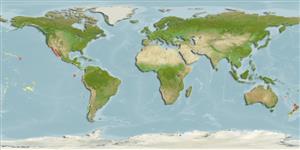Common names from other countries
>
Blenniiformes (Blennies) >
Blenniidae (Combtooth blennies) > Salariinae
Etymology: Hypsoblennius: Greek, hypsi = high + Greek, blennios = mucus (Ref. 45335).
More on author: Girard.
Environment: milieu / climate zone / depth range / distribution range
Ecología
marino; salobre demersal; rango de profundidad 0 - 25 m (Ref. 37955), usually ? - 10 m (Ref. 56052). Subtropical; 37°N -
Eastern Central Pacific: Monterey Bay, California, USA to Bahia Magdalena (Baja California Sur, Mexico) and the Gulf of California.
Tamaño / Peso / Age
Maturity: Lm ? range ? - ? cm
Max length : 15.0 cm TL macho / no sexado; (Ref. 2850); edad máxima reportada: 7 años (Ref. 56052)
Adults are found in intertidal shallows (Ref. 11482). Territorial (Ref. 37955). They feed on small benthic invertebrates and algae (Ref. 37955). Demersal spawners in nearshore habitats (Ref. 56049). Oviparous (Ref. 205). Eggs are demersal and adhesive (Ref. 205), and are attached to the walls of the parent's shelter. Eggs are brooded by the male parent (Ref. 56053).
Life cycle and mating behavior
Maturities | Reproducción | Spawnings | Egg(s) | Fecundities | Larva
Oviparous, distinct pairing (Ref. 205). Female deposits the eggs in protected areas. The male guards the eggs until hatching (Ref. 37955).
Eschmeyer, W.N., E.S. Herald and H. Hammann, 1983. A field guide to Pacific coast fishes of North America. Boston (MA, USA): Houghton Mifflin Company. xii+336 p. (Ref. 2850)
IUCN Red List Status (Ref. 130435)
CITES (Ref. 128078)
Not Evaluated
Threat to humans
Harmless
Human uses
Pesquerías: comercial; Acuario: Comercial
Herramientas
Special reports
Download XML
Fuentes de Internet
Estimates based on models
Preferred temperature (Ref.
115969): 16.2 - 25.9, mean 21 (based on 201 cells).
Phylogenetic diversity index (Ref.
82804): PD
50 = 0.5000 [Uniqueness, from 0.5 = low to 2.0 = high].
Bayesian length-weight: a=0.00832 (0.00454 - 0.01523), b=3.02 (2.86 - 3.18), in cm Total Length, based on LWR estimates for this species & (Sub)family-body (Ref.
93245).
Nivel trófico (Ref.
69278): 2.7 ±0.24 se; based on food items.
Resiliencia (Ref.
120179): Medio, población duplicada en un tiempo mínimo de 1.4-4.4 años (tmax=6.5).
Fishing Vulnerability (Ref.
59153): Low vulnerability (10 of 100).
